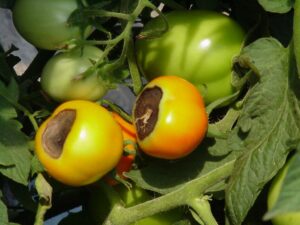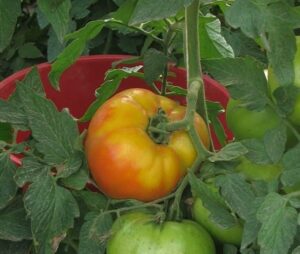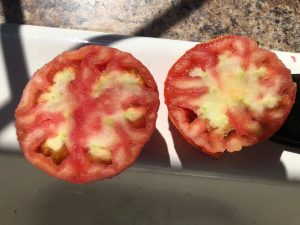As tomatoes bloom and set fruit it is a good time to review practices for avoiding some common fruit problems. Water management is key to avoiding blossom end rot. Adequate potassium is important to reduce yellow shoulder and internal white tissue. This article provides more information on these topics, and includes some information previously published in issues 558 and 599 of this newsletter.
Blossom end rot is a physiological disorder caused by a deficient supply of calcium to the developing fruit. It is a common problem on tomatoes, but can also occur on peppers, eggplants, and melons. Blossom end rot appears first as a small darkened or water soaked area, usually at the blossom end of the fruit (Figure 1). This spot darkens, enlarges and dries out as fruit matures. The area may be invaded by secondary decay causing organisms. Prevention is the best way to avoid losses from blossom end rot. Prevention strategies emphasize ensuring adequate supply and availability of calcium, and managing plant growth environmental conditions to promote movement of calcium to the developing fruit.
If I could offer just one suggestion for avoiding blossom end rot it would be to maintain a consistent water supply. In many cases I have seen, this is a key factor. Any interruption of water supply to the roots, for example during hot dry weather, can cause a temporary calcium deficiency in the developing fruit that will lead to blossom end rot. A sudden change to hot sunny weather after a period of cloudiness may promote blossom end rot due to the increase in water demand. In protected culture increasing humidity may reduce blossom end rot because the plant demand for water will be reduced.
Nutrient management is also important. Check that soil calcium levels are sufficient, and in cultural systems where most calcium is supplied through fertigation, assure that sufficient amounts are being applied. In many Indiana high tunnels, soil calcium levels are high as a result of irrigation with hard water. Even in outdoor fields, calcium levels are often sufficient and it is getting the calcium to the developing fruit that is the problem. Avoid excess nitrogen. Nitrogen promotes vegetative growth that can compete with the developing fruit for an adequate supply of calcium, leading to blossom end rot. Avoid excess potassium or magnesium because they can interfere with uptake of calcium. High electrical conductivity (EC) in a soilless culture system can also promote blossom end rot.
In addition to managing nutrients and water, providing conditions for a healthy root system is important. Avoid compaction and provide good drainage.
Varieties differ in susceptibility to blossom end rot. Plum types are often more prone to the disorder; it is virtually unknown in cherry tomatoes.
Blossom end rot can cause significant losses and is a problem that can be avoided with proper management. It may take some investigation to determine what measures will be effective in a particular situation; time well spent if it reduces the loss of marketable fruit.
Yellow shoulder and internal white tissue are disorders that become visible on ripe tomatoes. Yellow shoulder describes yellow hard areas near the stem end of tomato fruit that fail to ripen properly (Figure 2). Even on fruit that doesn’t show the distinct yellow on the shoulder, cutting across the top of the fruit will reveal internal white tissue that is also associated with the disorder (Figure 3). A variety of factors make this problem more likely to occur, including genetics, temperature, and potassium nutrition. The article Tomato Varieties Differ in Susceptibility to Internal White Tissue Disorder published last August in issue 680 of this newsletter provided information on susceptibility of some fresh market varieties to this disorder. Temperatures in high tunnels can be managed to some extent with ventilation and use of shade cloth.
Potassium nutrition is important to address early in the season. Tomato fruit contain large amounts of potassium, about 0.35 lb. K2O per 100 lb. of fruit, and if the potassium is not available in the soil as plants and fruit grow, disorders can develop. Consider taking some time now to review how potassium is managed for the tomato crop.
A common approach is to use a soil test before planting to assess the potassium supply of the soil. Based on the test, a recommendation for the amount of potassium to add is developed that takes into account the soil type and the expected tomato yield. For example, if the soil test reports 115 ppm K for a soil with cation exchange capacity (CEC) of 4, the recommendation would be to add enough potassium to replace what is removed by the harvested crop. For a yield of 30 tons/acre, that would be 210 lb. K2O/A. For a yield of 2500 lb./1000 sq. ft. that would be 8.75 lb. K2O/1000 sq. ft. The potassium should be in the root zone before the plant needs it, either applied before planting, or in several applications over the season, or routinely through a fertigation system. A rate of 1 to 3 lb. K2O /A/day (0.0229 to 0.0687 lb. K2O/1000 sq. ft. /day) could be appropriate in a fertigation system, depending on soil K levels and crop need. A video working through calculations for potassium fertilizer application is available at https://www.youtube.com/watch?v=73s3m8Ke3r4.
Assuring that soil potassium is available to the tomato crop is also important. In addition to placing nutrients in the root zone, pay attention to supplying adequate water in that zone. Also, remember that excess supply of other positively charged nutrients (e.g. calcium and magnesium) can interfere with potassium uptake by the plant.
It can be difficult or impossible to know, just by looking at a crop, whether nutrient levels in the plant are sufficient. Deficiencies occur before visible symptoms occur. For this reason, plant tissue tests are recommended for new growers, in situations where yellow shoulder or internal white tissue have previously been a problem, and for others wanting to assess crop nutrition. Samples collected early in the season and then every two or three weeks will alert you to potential problems so that nutrient application can be adjusted if needed. A & L Great Lakes Laboratory, Fort Wayne, IN and Waters Ag Lab, Owensboro, KY are examples of commercial labs that routinely perform plant tissue tests.


